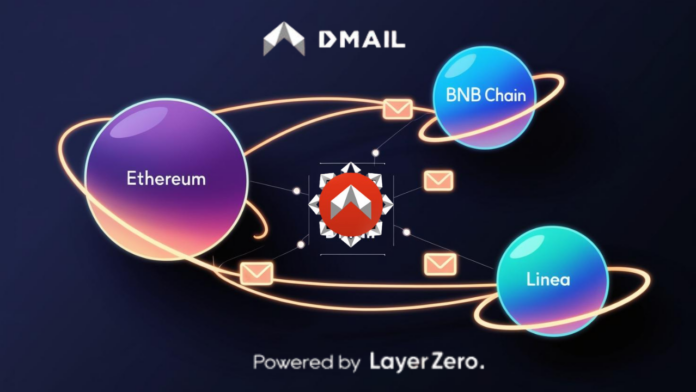Dmail has landed on Interport, opening up an easier route for users to move their $DMAIL tokens between Ethereum, BNB Chain, and Linea. This is the kind of development that speaks to where web3 infrastructure is headed—practical tools, fewer steps, and a wider reach across chains that don’t always speak the same language. With Interport Finance acting as the go-between and LayerZero handling the underlying tech, the update promises a smoother user experience for anyone working across these networks.
The cross-chain bridge means users can now transfer $DMAIL without detouring through multiple apps or exchanges. Instead of being boxed into one chain, holders can hop between Ethereum, BSC, and Linea in a few clicks. That convenience is a big win, especially when paired with the assurance that LayerZero’s interoperability protocol is handling the communication underneath. The result is faster movement of assets with less room for error—and, more importantly, less user anxiety.
Dmail’s positioning has always been about secure, decentralised messaging, aiming to bring email-style communication into the web3 space without relying on Web2’s centralised architecture. That kind of ambition can only work if the infrastructure is reliable and flexible, which is where cross-chain compatibility comes in. Bringing $DMAIL onto Interport doesn’t just expand where the token can travel—it’s a nudge toward making decentralised comms actually accessible to people who aren’t glued to one ecosystem.
Interport Finance is gaining ground as a bridge tool that isn’t trying to reinvent user habits, but rather clean them up. It handles assets like a mail sorter with decent precision, passing tokens where they need to go while trimming out the fuss. The partnership with LayerZero adds some extra weight, given LayerZero’s traction as a cross-chain protocol that’s already used by major DeFi players. With LayerZero in the mix, Dmail users don’t need to worry about whether the message—or in this case, the token—gets delivered safely.
The broader context is clear: people are tired of being pinned down to a single chain. Between gas fees, speed, and the different cultures of Ethereum and BSC, there’s a natural urge to mix and match depending on what you’re trying to do. Some users want the security and reputation of Ethereum, others prefer the lower costs of BSC, and some are starting to explore newer chains like Linea. For token projects like Dmail to succeed, they need to go where the users are, not ask users to bend to the project’s limitations.
What this does is bring Dmail closer to everyday usability. It’s one thing to talk about decentralised communication, but if it only works on a single chain, it’s not reaching its full audience. Being able to bridge $DMAIL without complex steps means that more people can get involved, whether they’re staking, voting, or using the token for services tied to the messaging platform. There’s less friction, and that kind of usability is what pushes a protocol from interesting to actually useful.
And it’s not stopping here. The announcement that ckDMAIL will be live soon suggests a continuation of this multichain approach, potentially expanding both reach and functionality. While the details of ckDMAIL aren’t spelled out in full yet, the naming convention suggests a wrapped or bridged version of the token—something that aligns with LayerZero’s history of enabling omnichain assets. That move would make Dmail one of the growing number of projects thinking beyond “porting” and leaning into actual presence across chains at the same time.
There’s an interesting contrast between how Interport and LayerZero function behind the scenes and how the end experience feels to users. On the back end, you’ve got complex routing, token standards, and security protocols making sure everything is where it should be. On the front end, all users see is a cleaner UI and faster results. That’s the whole point—abstracting the complexity without watering down the function. And in a space where users are rightly wary of bridges due to past exploits, the LayerZero angle adds a layer of credibility. It’s not just a matter of speed—it’s also about trust in the stack.
Dmail isn’t just riding the LayerZero wave, though. The project has carved out a niche in decentralised messaging, offering encrypted, wallet-to-wallet communication with features like scheduled messages and NFT attachments. Those functions become much more valuable when they’re chain-agnostic. If users can send a message regardless of which chain their wallet is tied to—or use Dmail’s services without needing to convert their tokens elsewhere first—that’s when the protocol moves beyond novelty.
There’s a growing pressure on all Web3 projects to show utility that extends beyond speculation. Dmail’s cross-chain step is part of that pressure being met. Bridging doesn’t just mean movement—it means that protocols are beginning to adapt to how people actually use the space, whether that’s casually hopping between chains or building more integrated workflows. Users want to feel that their activity isn’t being boxed in, and projects want their tokens to be present wherever attention is shifting.
The timing of this move is also worth noting. Ethereum scaling is still a work in progress, BSC remains a go-to for cheaper and faster transactions, and Linea is positioning itself as a newer alternative looking to carve out a piece of the Layer 2 conversation. By planting a flag in each of these, Dmail is placing a bet on diversity—both in terms of user base and technical capacity. And if that’s paired with consistent performance and low-friction bridging, it’s a sensible route to take.
Of course, multichain compatibility alone doesn’t make a project essential. But it does mean Dmail now has more ways to demonstrate why it should be on people’s radar. Messaging might not be the flashiest part of Web3, but it’s one of the few things everyone actually needs. Whether you’re an NFT collector, DeFi trader, or DAO participant, secure comms are part of the deal. If those messages can travel as easily as the tokens that fuel the ecosystem, that’s one less headache to deal with.
There’s still some waiting involved, especially around ckDMAIL and how that will play into the broader Dmail structure. But the overall direction is clear. Less chain-locking, more flexibility. Better interoperability, simpler flows. If Dmail can keep stitching those parts together while holding onto its security focus, it might be one of the few projects that turns cross-chain comms into something people actually use—not just something they talk about.
Until then, the addition of $DMAIL to Interport is a neat improvement that users can test straight away. Whether you’re shifting tokens for access, liquidity, or just convenience, the process is now shorter, simpler, and—if the tech holds—safer. That’s a pretty solid place to start.


